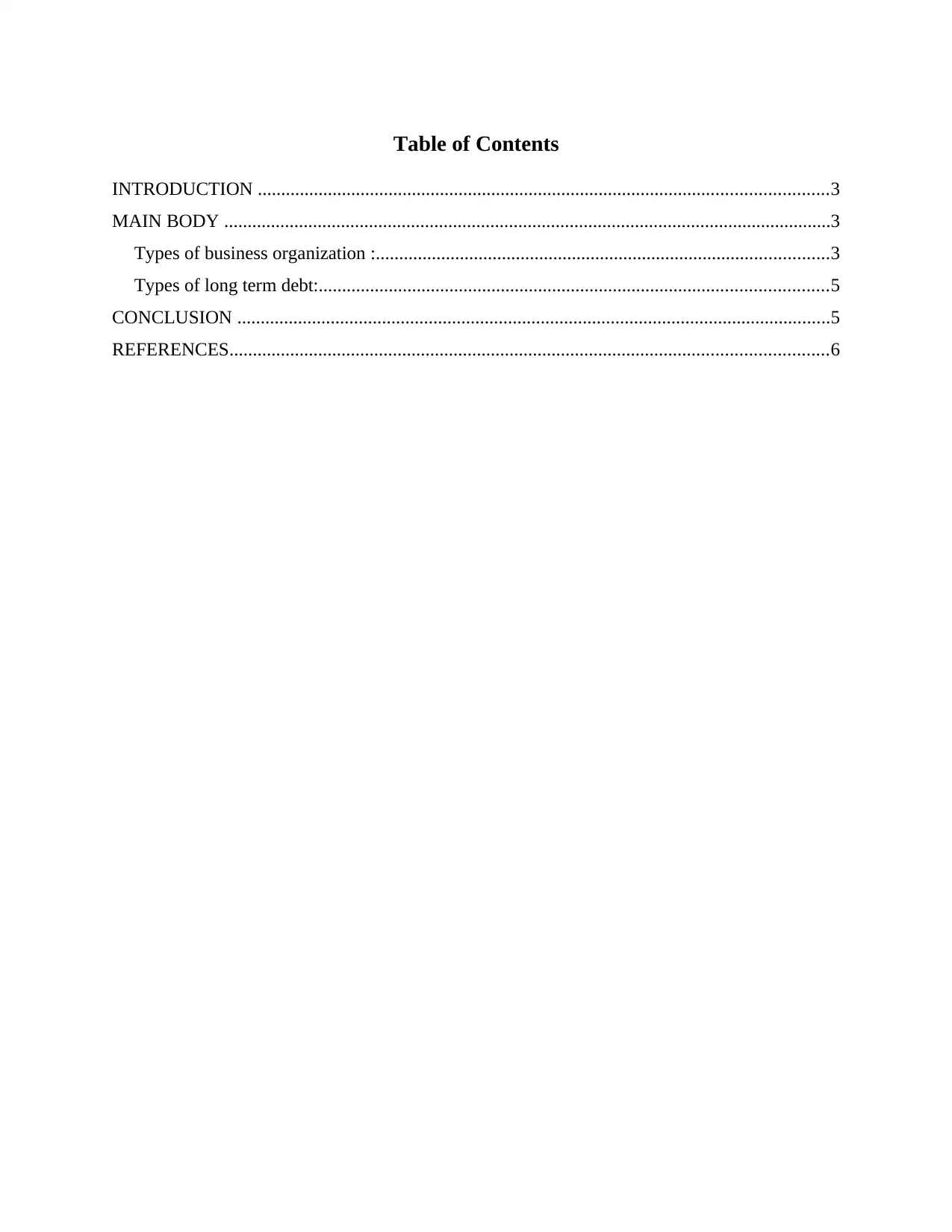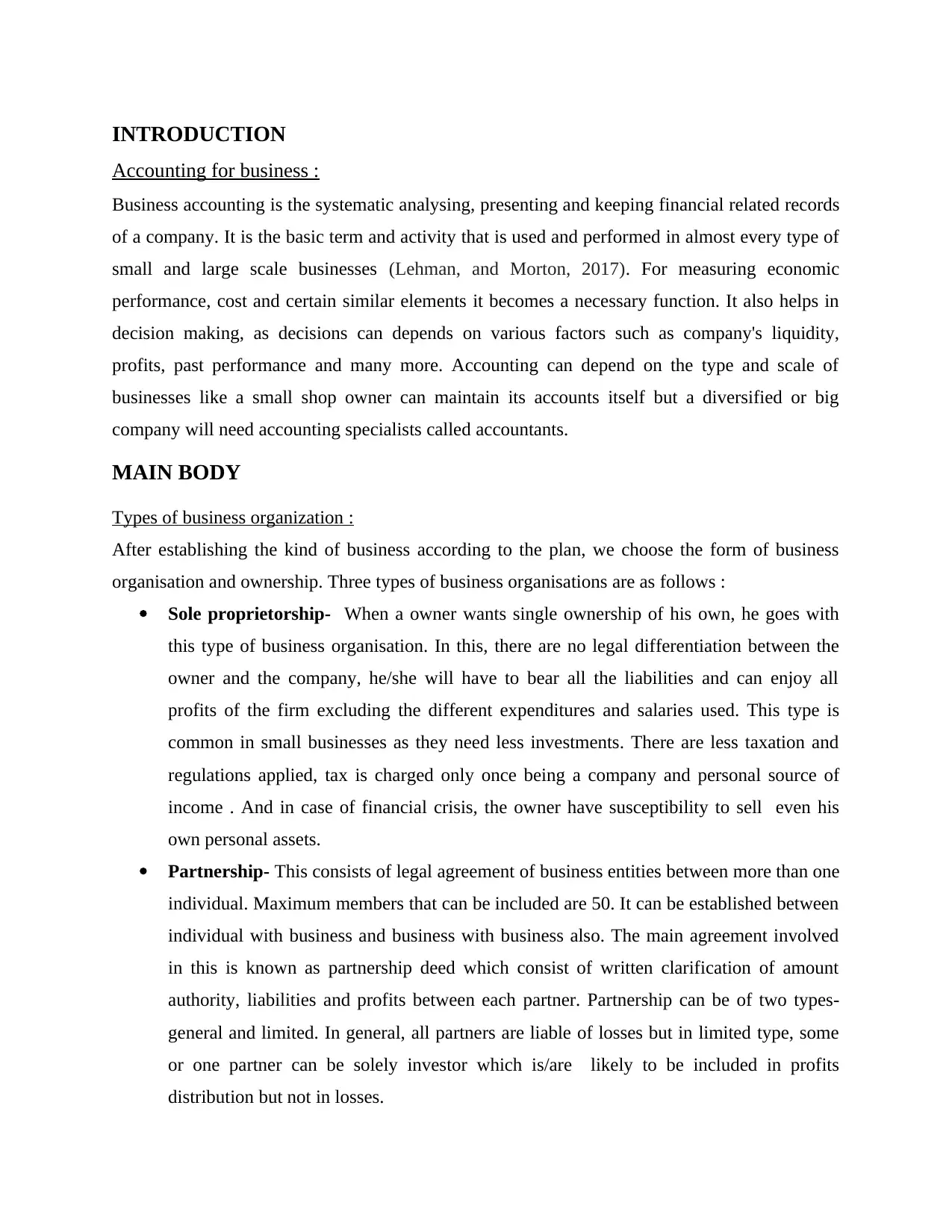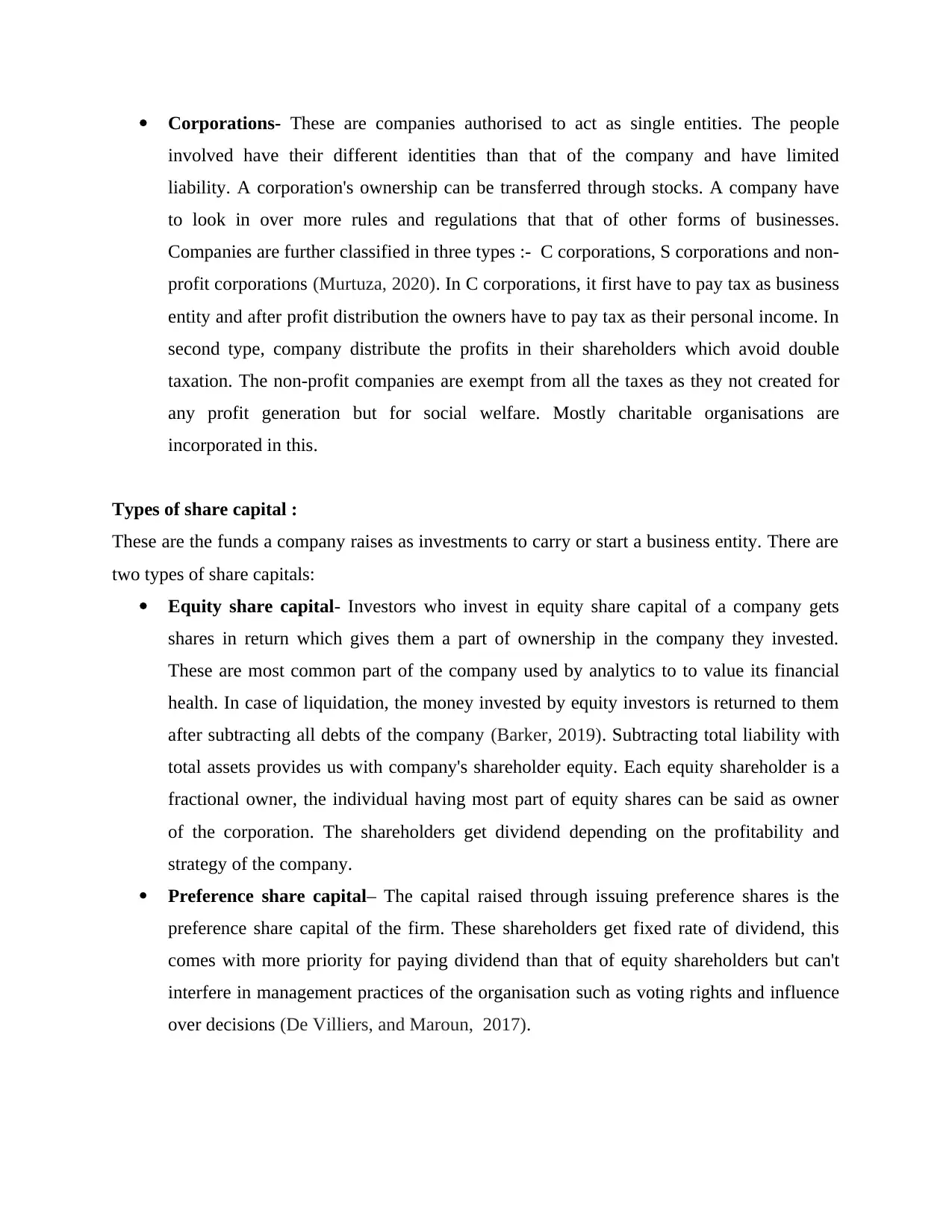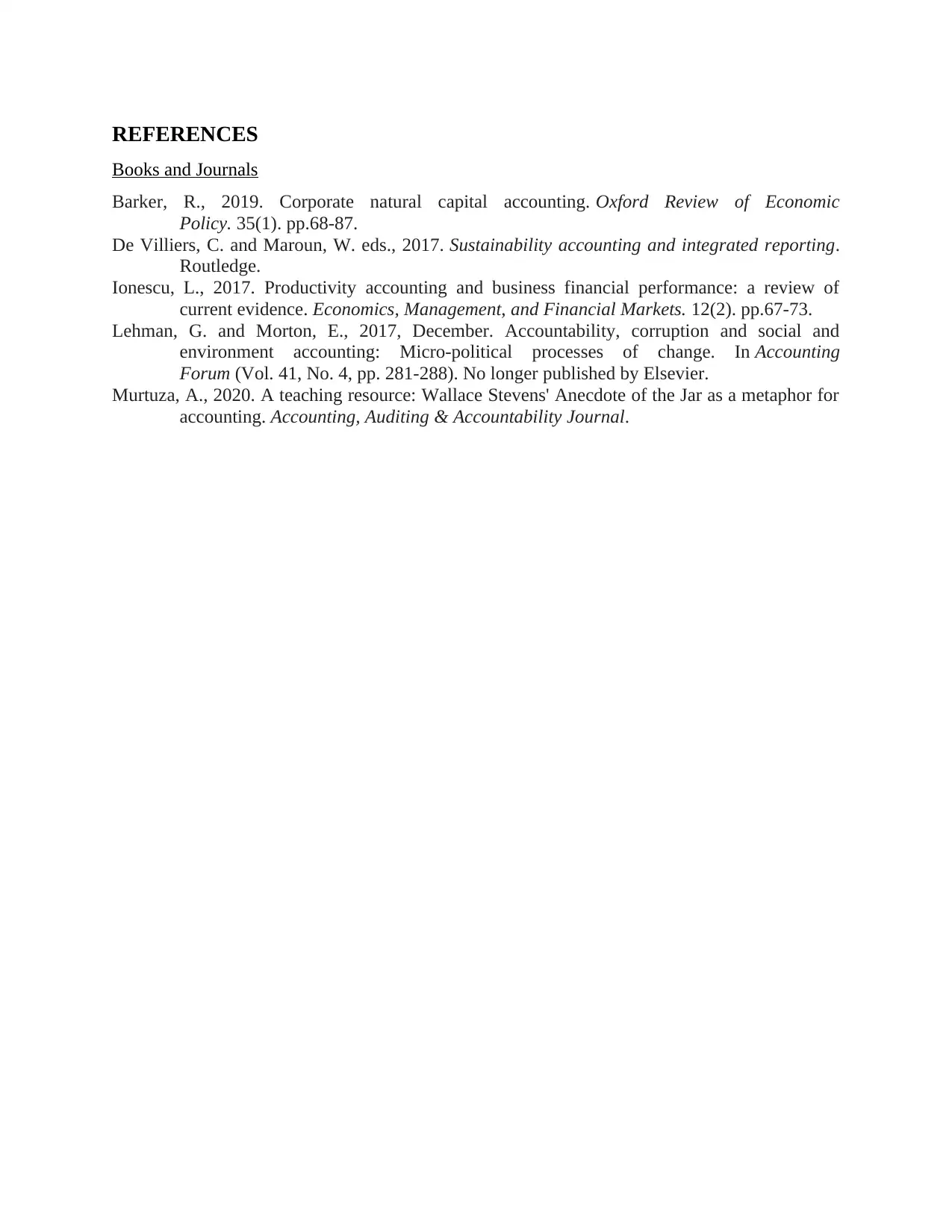Accounting for Business: Comparative Analysis of Business Types
VerifiedAdded on 2023/06/16
|7
|1345
|384
Essay
AI Summary
This essay provides a comprehensive overview of accounting for business, focusing on different types of business enterprises: sole proprietorships, partnerships, and corporations. It delves into the characteristics of each type, including ownership structure, liability, taxation, and regulatory requirements. The essay also discusses the different types of share capital, such as equity and preference shares, and long-term debt, including corporate bonds and treasuries, highlighting their risk profiles and investment considerations. The report concludes that business accounting is essential for the smooth operation of companies and provides a detailed analysis of the various aspects of business organizations and financing.

Accounting for
Business
Business
Paraphrase This Document
Need a fresh take? Get an instant paraphrase of this document with our AI Paraphraser

Table of Contents
INTRODUCTION ..........................................................................................................................3
MAIN BODY ..................................................................................................................................3
Types of business organization :.................................................................................................3
Types of long term debt:.............................................................................................................5
CONCLUSION ...............................................................................................................................5
REFERENCES................................................................................................................................6
INTRODUCTION ..........................................................................................................................3
MAIN BODY ..................................................................................................................................3
Types of business organization :.................................................................................................3
Types of long term debt:.............................................................................................................5
CONCLUSION ...............................................................................................................................5
REFERENCES................................................................................................................................6

INTRODUCTION
Accounting for business :
Business accounting is the systematic analysing, presenting and keeping financial related records
of a company. It is the basic term and activity that is used and performed in almost every type of
small and large scale businesses (Lehman, and Morton, 2017). For measuring economic
performance, cost and certain similar elements it becomes a necessary function. It also helps in
decision making, as decisions can depends on various factors such as company's liquidity,
profits, past performance and many more. Accounting can depend on the type and scale of
businesses like a small shop owner can maintain its accounts itself but a diversified or big
company will need accounting specialists called accountants.
MAIN BODY
Types of business organization :
After establishing the kind of business according to the plan, we choose the form of business
organisation and ownership. Three types of business organisations are as follows :
Sole proprietorship- When a owner wants single ownership of his own, he goes with
this type of business organisation. In this, there are no legal differentiation between the
owner and the company, he/she will have to bear all the liabilities and can enjoy all
profits of the firm excluding the different expenditures and salaries used. This type is
common in small businesses as they need less investments. There are less taxation and
regulations applied, tax is charged only once being a company and personal source of
income . And in case of financial crisis, the owner have susceptibility to sell even his
own personal assets.
Partnership- This consists of legal agreement of business entities between more than one
individual. Maximum members that can be included are 50. It can be established between
individual with business and business with business also. The main agreement involved
in this is known as partnership deed which consist of written clarification of amount
authority, liabilities and profits between each partner. Partnership can be of two types-
general and limited. In general, all partners are liable of losses but in limited type, some
or one partner can be solely investor which is/are likely to be included in profits
distribution but not in losses.
Accounting for business :
Business accounting is the systematic analysing, presenting and keeping financial related records
of a company. It is the basic term and activity that is used and performed in almost every type of
small and large scale businesses (Lehman, and Morton, 2017). For measuring economic
performance, cost and certain similar elements it becomes a necessary function. It also helps in
decision making, as decisions can depends on various factors such as company's liquidity,
profits, past performance and many more. Accounting can depend on the type and scale of
businesses like a small shop owner can maintain its accounts itself but a diversified or big
company will need accounting specialists called accountants.
MAIN BODY
Types of business organization :
After establishing the kind of business according to the plan, we choose the form of business
organisation and ownership. Three types of business organisations are as follows :
Sole proprietorship- When a owner wants single ownership of his own, he goes with
this type of business organisation. In this, there are no legal differentiation between the
owner and the company, he/she will have to bear all the liabilities and can enjoy all
profits of the firm excluding the different expenditures and salaries used. This type is
common in small businesses as they need less investments. There are less taxation and
regulations applied, tax is charged only once being a company and personal source of
income . And in case of financial crisis, the owner have susceptibility to sell even his
own personal assets.
Partnership- This consists of legal agreement of business entities between more than one
individual. Maximum members that can be included are 50. It can be established between
individual with business and business with business also. The main agreement involved
in this is known as partnership deed which consist of written clarification of amount
authority, liabilities and profits between each partner. Partnership can be of two types-
general and limited. In general, all partners are liable of losses but in limited type, some
or one partner can be solely investor which is/are likely to be included in profits
distribution but not in losses.
⊘ This is a preview!⊘
Do you want full access?
Subscribe today to unlock all pages.

Trusted by 1+ million students worldwide

Corporations- These are companies authorised to act as single entities. The people
involved have their different identities than that of the company and have limited
liability. A corporation's ownership can be transferred through stocks. A company have
to look in over more rules and regulations that that of other forms of businesses.
Companies are further classified in three types :- C corporations, S corporations and non-
profit corporations (Murtuza, 2020). In C corporations, it first have to pay tax as business
entity and after profit distribution the owners have to pay tax as their personal income. In
second type, company distribute the profits in their shareholders which avoid double
taxation. The non-profit companies are exempt from all the taxes as they not created for
any profit generation but for social welfare. Mostly charitable organisations are
incorporated in this.
Types of share capital :
These are the funds a company raises as investments to carry or start a business entity. There are
two types of share capitals:
Equity share capital- Investors who invest in equity share capital of a company gets
shares in return which gives them a part of ownership in the company they invested.
These are most common part of the company used by analytics to to value its financial
health. In case of liquidation, the money invested by equity investors is returned to them
after subtracting all debts of the company (Barker, 2019). Subtracting total liability with
total assets provides us with company's shareholder equity. Each equity shareholder is a
fractional owner, the individual having most part of equity shares can be said as owner
of the corporation. The shareholders get dividend depending on the profitability and
strategy of the company.
Preference share capital– The capital raised through issuing preference shares is the
preference share capital of the firm. These shareholders get fixed rate of dividend, this
comes with more priority for paying dividend than that of equity shareholders but can't
interfere in management practices of the organisation such as voting rights and influence
over decisions (De Villiers, and Maroun, 2017).
involved have their different identities than that of the company and have limited
liability. A corporation's ownership can be transferred through stocks. A company have
to look in over more rules and regulations that that of other forms of businesses.
Companies are further classified in three types :- C corporations, S corporations and non-
profit corporations (Murtuza, 2020). In C corporations, it first have to pay tax as business
entity and after profit distribution the owners have to pay tax as their personal income. In
second type, company distribute the profits in their shareholders which avoid double
taxation. The non-profit companies are exempt from all the taxes as they not created for
any profit generation but for social welfare. Mostly charitable organisations are
incorporated in this.
Types of share capital :
These are the funds a company raises as investments to carry or start a business entity. There are
two types of share capitals:
Equity share capital- Investors who invest in equity share capital of a company gets
shares in return which gives them a part of ownership in the company they invested.
These are most common part of the company used by analytics to to value its financial
health. In case of liquidation, the money invested by equity investors is returned to them
after subtracting all debts of the company (Barker, 2019). Subtracting total liability with
total assets provides us with company's shareholder equity. Each equity shareholder is a
fractional owner, the individual having most part of equity shares can be said as owner
of the corporation. The shareholders get dividend depending on the profitability and
strategy of the company.
Preference share capital– The capital raised through issuing preference shares is the
preference share capital of the firm. These shareholders get fixed rate of dividend, this
comes with more priority for paying dividend than that of equity shareholders but can't
interfere in management practices of the organisation such as voting rights and influence
over decisions (De Villiers, and Maroun, 2017).
Paraphrase This Document
Need a fresh take? Get an instant paraphrase of this document with our AI Paraphraser

Types of long term debt:
These comes in non current liabilities in balance sheet of a company. They have fixed times
frame for repayment including the decided interest rate. Two types of long term debt are as
follows:
Corporate bonds- These carry with higher chances of risk than other types of debts.
Because of carrying high risk they are rated by certain rating agencies depending on their
past return performance. These also trade in secondary market for buying and selling.
The highest quality of these are refereed as “Triple -A” bonds while the lowest quality as
“Junk”. Higher risk of these provides with higher returns to the owners. After maturity
the owner gets his whole invested money and even receives fixed or variable rate of
interests every year.
Treasuries- These are government issued bonds in which an investor agrees for lending
money to the government subsidiaries at a fixed interest rate. Government then uses the
money to fund its projects or schemes. This type of long term debt have maturity period
of 10 or more years (Ionescu, 2017). These comes under one of the safest investments in
the market. For repayment of these bonds, if needed, the government can raise tax too, so
these are the one of only practically risk free investments. Due to its safe safe nature, the
compounding rate of the investment is also low.
CONCLUSION
From the above mentioned report it has been concluded that, business accounting is a
must used element in smooth working of companies. The report than defines about certain types
of business organisations. Three types business organisations sole proprietorship, partnership and
corporates/companies are than elaborated. It then covers about the two types of share capital
used in businesses for raising funds - equity share capital and preference share capital. These
types are notified in detail. Moving further, it covers two important types of long term debts-
corporate bonds and treasuries. The elements further defines about the involved risks, further
small types and duration of maturity period.
These comes in non current liabilities in balance sheet of a company. They have fixed times
frame for repayment including the decided interest rate. Two types of long term debt are as
follows:
Corporate bonds- These carry with higher chances of risk than other types of debts.
Because of carrying high risk they are rated by certain rating agencies depending on their
past return performance. These also trade in secondary market for buying and selling.
The highest quality of these are refereed as “Triple -A” bonds while the lowest quality as
“Junk”. Higher risk of these provides with higher returns to the owners. After maturity
the owner gets his whole invested money and even receives fixed or variable rate of
interests every year.
Treasuries- These are government issued bonds in which an investor agrees for lending
money to the government subsidiaries at a fixed interest rate. Government then uses the
money to fund its projects or schemes. This type of long term debt have maturity period
of 10 or more years (Ionescu, 2017). These comes under one of the safest investments in
the market. For repayment of these bonds, if needed, the government can raise tax too, so
these are the one of only practically risk free investments. Due to its safe safe nature, the
compounding rate of the investment is also low.
CONCLUSION
From the above mentioned report it has been concluded that, business accounting is a
must used element in smooth working of companies. The report than defines about certain types
of business organisations. Three types business organisations sole proprietorship, partnership and
corporates/companies are than elaborated. It then covers about the two types of share capital
used in businesses for raising funds - equity share capital and preference share capital. These
types are notified in detail. Moving further, it covers two important types of long term debts-
corporate bonds and treasuries. The elements further defines about the involved risks, further
small types and duration of maturity period.

REFERENCES
Books and Journals
Barker, R., 2019. Corporate natural capital accounting. Oxford Review of Economic
Policy. 35(1). pp.68-87.
De Villiers, C. and Maroun, W. eds., 2017. Sustainability accounting and integrated reporting.
Routledge.
Ionescu, L., 2017. Productivity accounting and business financial performance: a review of
current evidence. Economics, Management, and Financial Markets. 12(2). pp.67-73.
Lehman, G. and Morton, E., 2017, December. Accountability, corruption and social and
environment accounting: Micro-political processes of change. In Accounting
Forum (Vol. 41, No. 4, pp. 281-288). No longer published by Elsevier.
Murtuza, A., 2020. A teaching resource: Wallace Stevens' Anecdote of the Jar as a metaphor for
accounting. Accounting, Auditing & Accountability Journal.
Books and Journals
Barker, R., 2019. Corporate natural capital accounting. Oxford Review of Economic
Policy. 35(1). pp.68-87.
De Villiers, C. and Maroun, W. eds., 2017. Sustainability accounting and integrated reporting.
Routledge.
Ionescu, L., 2017. Productivity accounting and business financial performance: a review of
current evidence. Economics, Management, and Financial Markets. 12(2). pp.67-73.
Lehman, G. and Morton, E., 2017, December. Accountability, corruption and social and
environment accounting: Micro-political processes of change. In Accounting
Forum (Vol. 41, No. 4, pp. 281-288). No longer published by Elsevier.
Murtuza, A., 2020. A teaching resource: Wallace Stevens' Anecdote of the Jar as a metaphor for
accounting. Accounting, Auditing & Accountability Journal.
⊘ This is a preview!⊘
Do you want full access?
Subscribe today to unlock all pages.

Trusted by 1+ million students worldwide

1 out of 7
Related Documents
Your All-in-One AI-Powered Toolkit for Academic Success.
+13062052269
info@desklib.com
Available 24*7 on WhatsApp / Email
![[object Object]](/_next/static/media/star-bottom.7253800d.svg)
Unlock your academic potential
Copyright © 2020–2025 A2Z Services. All Rights Reserved. Developed and managed by ZUCOL.




